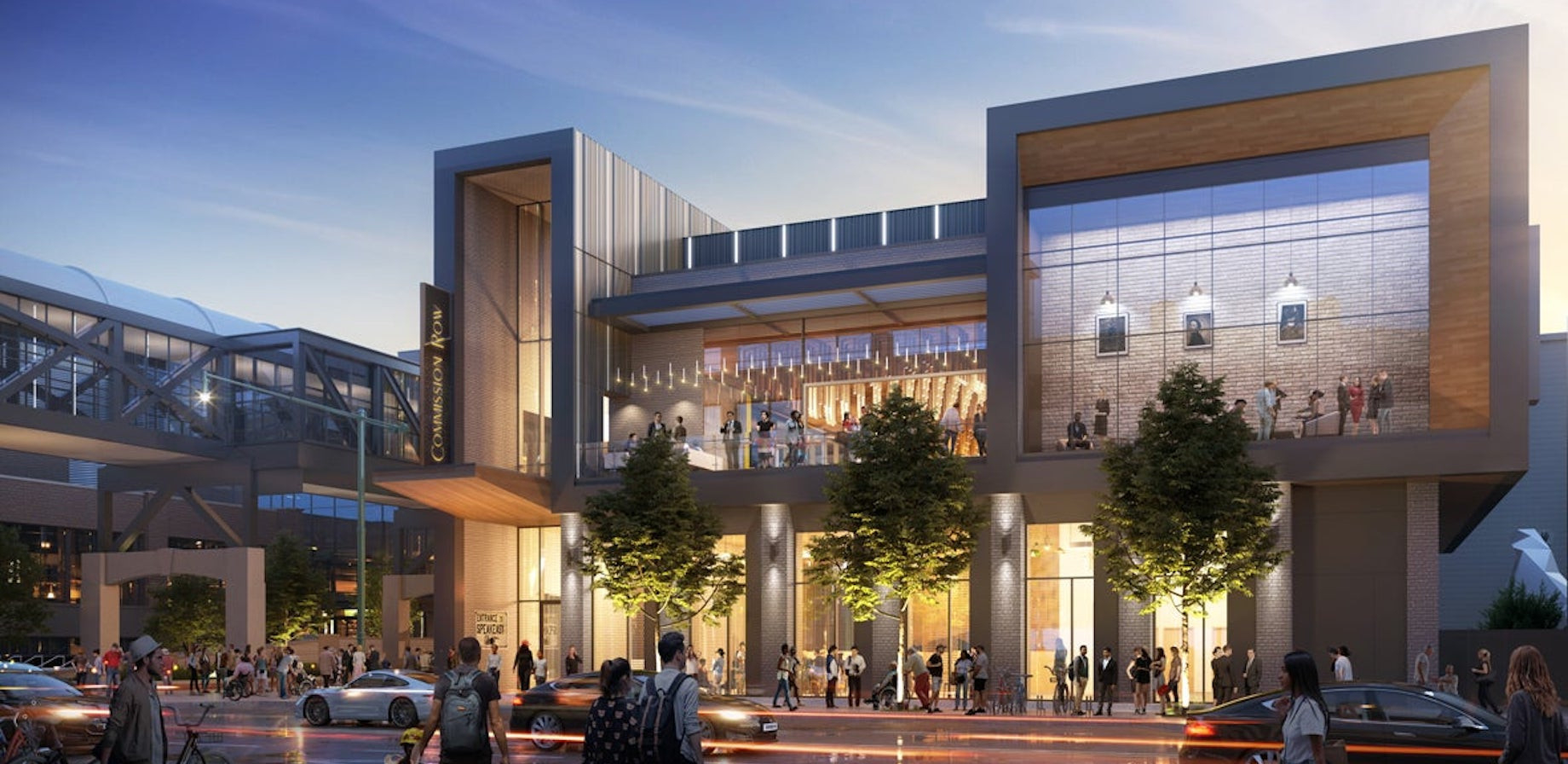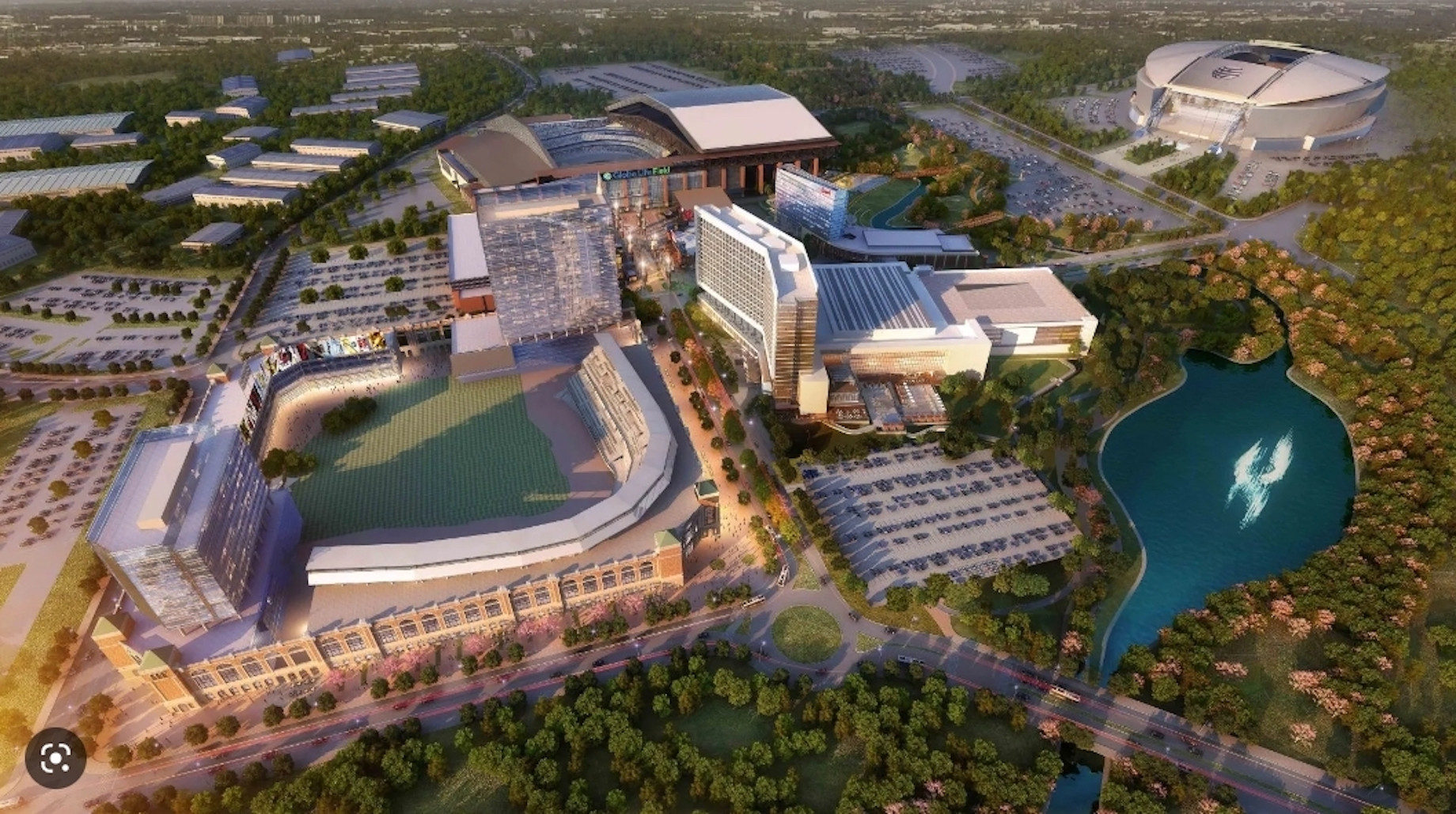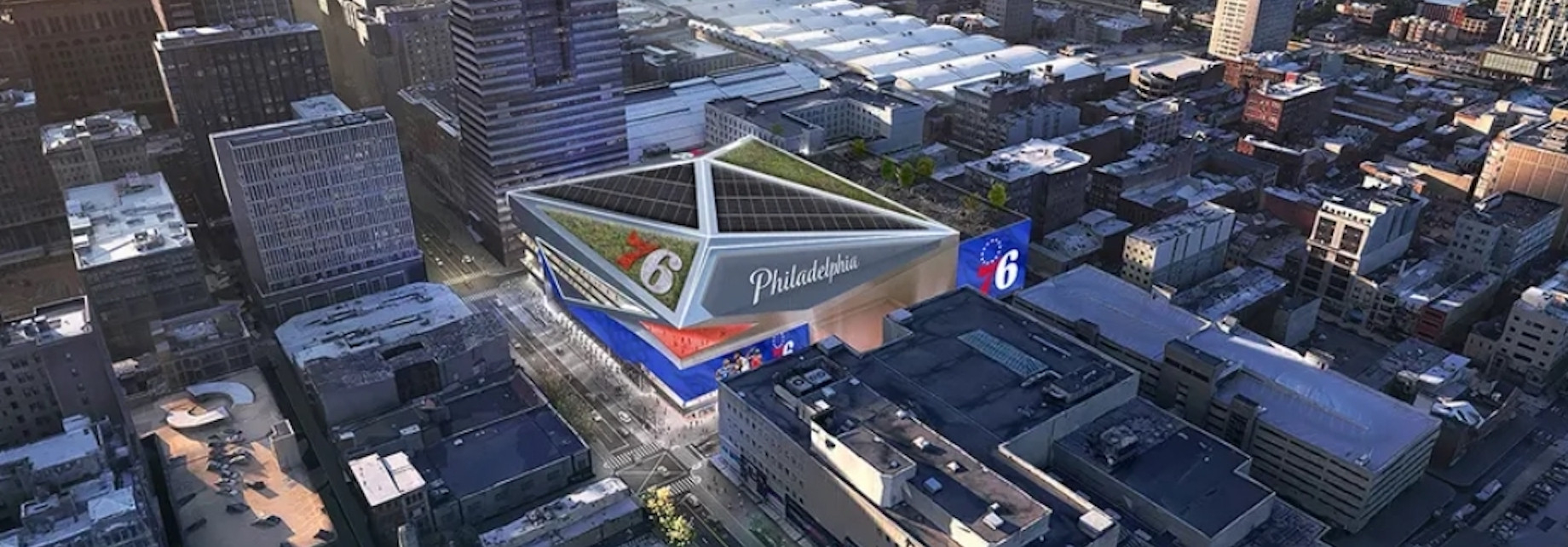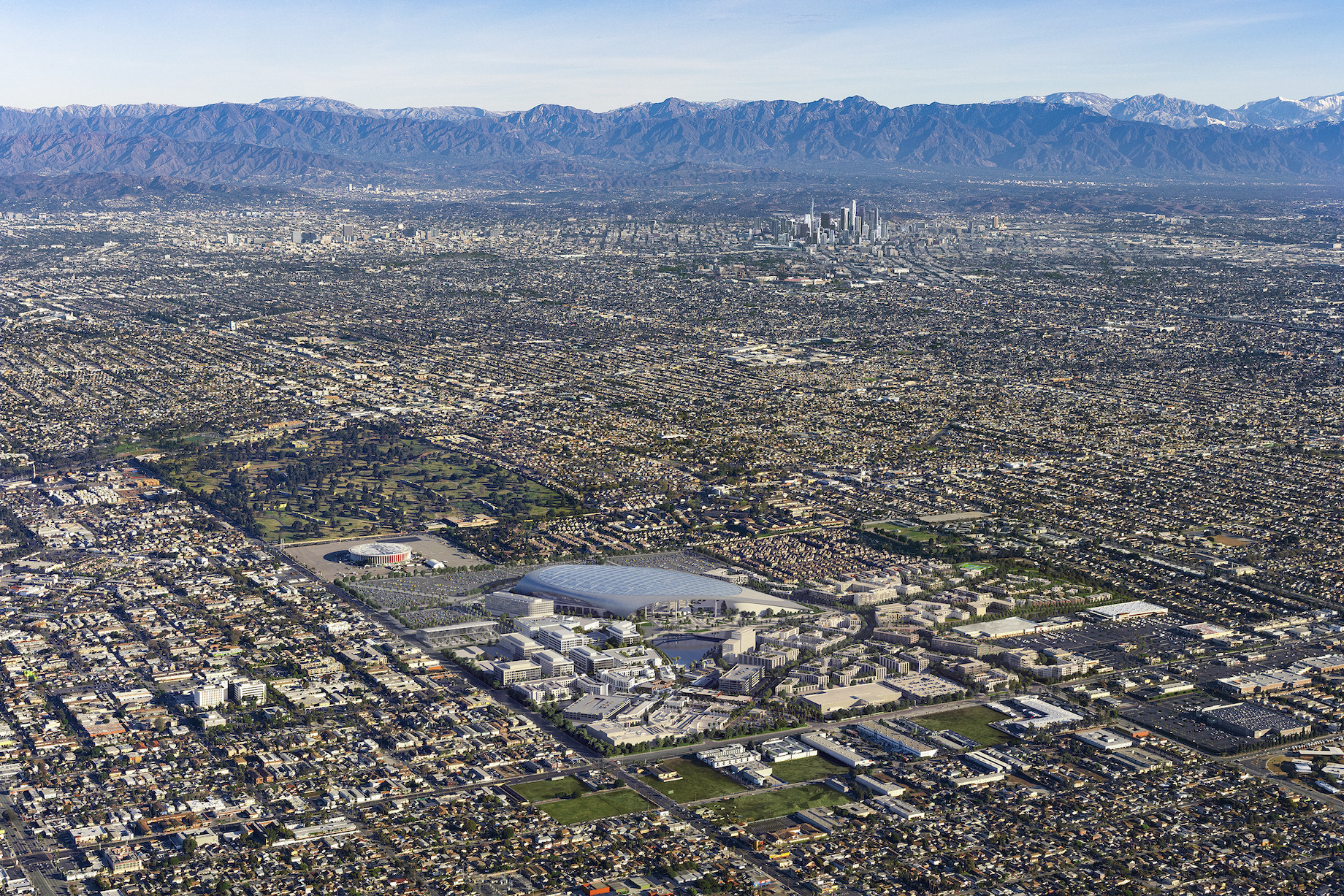An arena and stadium building boom across the U.S. is creating a new generation of master-planned entertainment districts designed to connect and support local communities.
“We have seen these sports and entertainment venues become the anchors of what really are traditional mixed-use developments,” said Phil Colicchio, co-chair of Cushman and Wakefield’s specialty food, beverage and entertainment group, known as Colicchio Consulting. “They are taking on that role because venue developers, which we always associate with sports for good reason, have recognized now that there are multiple ways to program these venues, to give them life 300 nights a year and probably almost half of that in terms of daytime programming. It doesn’t always need to be a basketball game; we have seen uses as broad as music, comedy, religious gatherings and food festivals. The ability to program is only limited by the imagination of the programmer.”
Indiana Pacers Home Court
A good example is taking shape in downtown Indianapolis, where the Pacers Sports & Entertainment, owner of the NBA’s Indiana Pacers, is putting the finishing touches on a $360 million public-private renovation of Gainbridge Fieldhouse. In conjunction, PS&E is redeveloping a nearby parking lot in Bicentennial Unity Plaza. It’s partnering with Indiana-based Cunningham Restaurant Group to create a three-level, 30,000-square-foot dining and entertainment venue. Called Commission Row, it will include a basement-level, vintage speakeasy whose capacity will exceed 150 guests; a street-level, high-end chophouse and seafood restaurant that will seat close to 250; and an upper-level space for special occasions and private events that can seat 250.

Renovation of downtown Indianapolis’ Gainbridge Fieldhouse, home to the NBA’s Pacers and WNBA’s Fever, has prompted development of Commission Row, above, which features a restaurant, a speakeasy and a large events venue. Rendering credit: Ratio
According to Cunningham Restaurant Group director of marketing Carissa Newton: “Our CEO, Mike Cunningham, is obviously very passionate about the Pacers and also passionate about downtown development and urban development, so I think those were two things that fit well together.”
Connecting to the community was a key factor in taking on the assignment. “We don’t want to be that project that just plops down in the middle of the downtown area and doesn’t have anything around it,” she said. “Everything for us is centered around the community where our businesses and our restaurants are operating, so if we can jump in and be part of an overall community that has programming — it has living space, it has destination or entertainment space and it has dining — then that is better for all the parties that are involved because it just creates a destination instead of just one location that you can go to and leave.”
Cowboys and Rangers Home Fields
In Arlington, Texas, between Dallas and Fort Worth, the massive Arlington Entertainment District is still taking shape after opening in 2018, sparking nearly $1 billion of new development.

The Arlington Entertainment District, home to the NFL’s Dallas Cowboys and MLB’s Texas Rangers, is generating almost $1 billion in mixed-use development.
Texas Live, a partnership between The Cordish Cos.’ and the MLB’s Texas Rangers, is a $250 million dining, entertainment and hospitality district nestled between the Rangers’ Globe Life Field and the Dallas Cowboys’ AT&T Stadium. The project is part of a greater $1.25 billion vision for the district that features this new Rangers ballpark; 200,000 square feet of restaurant, retail and entertainment venues; a full-service, 300-room convention hotel; 35,000 square feet of meeting and convention space; and a 5,000-capacity outdoor event pavilion. The district also has enticed the Arlington Museum of Art to relocate to a $30 million home set to open in early 2024.
“What I find amazing about the sports arena business is how the business of real estate has changed around it,” said CBRE global client strategist and senior economic advisor Spencer Levy. “Traditionally we used the term CBD for central business district, and now, we're seeing a term which I call “better business district,” where people want to live, work and play in the same place.”
76ers Potential New Home
That strategy is at play with a new proposal for an arena in downtown Philadelphia. The NBA’s 76ers plan to build a $1.3 billion arena called 76 Place in Center City on Market Street after demolition of part of Macerich’s Fashion District Philadelphia shopping center. The 76ers currently share Wells Fargo Center, built in 1996, with the NHL’s Flyers and the National Lacrosse League’s Wings. “If you look around the country at stadium districts that have been built in or around the city, they're thriving,” said CBRE senior vice president Spencer Yablon. “That real estate is bulletproof.”
However, the 76ers’ plan has met significant opposition, which claims it would displace a large number of residents and increase traffic in the dense downtown area.

If approved, Downtown Philadelphia’s 76 Place will be home to the NBA’s 76ers.
Yablon contrasts the proposed 76 Place and Lincoln Financial Field, about two miles south in South Philadelphia. He said Lincoln Financial Field, home to the NFL’s Eagles, lacks walkability. “What is being proposed [for the 76ers] is a no-brainer for Philadelphia,” he said. “It will serve to really liven up a section of the city that desperately needs it. There are pretty cool vibes in those connecting neighborhoods, so I think connecting all of that would be huge for the city. People would show up at 5 to 6 p.m., have an early dinner, go into the game, come out at night and have a few drinks. I think it would serve to really invigorate the businesses in the neighborhood, and people want to live next to that.”
Colicchio said the 76 Place story is one to watch. “The arguments on both sides are very compelling,” he said. “We wouldn’t have that argument if the Philadelphia 76ers and the Philadelphia Flyers posture themselves to move across the river to Camden, [New Jersey], where they would be welcomed with open arms. But instead, they want to move closer to the interior of the city, and that is going to displace some people and some businesses. It may enhance their lives in 10 years, but during the building process, it’s going to be a major stress. Everybody has got a stake.”
Rams and Chargers’ Shared Home
In Los Angeles, the huge Hollywood Park is taking shape around four major sports and entertainment venues, including the 70,000-seat SoFi Stadium, host of the February 2023 Super Bowl LVII; the 6,000-seat YouTube Theater; the 2.5-acre, open-air American Airlines Plaza; and soon, a Los Angeles edition of the Cosm immersive experience. “Our venues host an incredible variety of events year-round, such as sports, entertainment, community, esports, comedy, award shows and more,” said SoFi Stadium and Hollywood Park managing director Jason Gannon. “The events we host actively engage our local Inglewood community and the Los Angeles region, as well as bring in visitors from around the country and the world.”

The developer of Los Angeles’ Hollywood Park is finding ways to connect its multiple sports and entertainment venues — including SoFi Stadium, home of the NFL’s Chargers and Rams — to the local community.
Core to the development’s planning was how to connect to the local community. “Being a steward of our community is incredibly important to us,” said Gannon. NFL franchise “Los Angeles Rams owner and chairman Stan Kroenke’s vision was to build a sports and entertainment destination that engaged the community on multiple levels. When complete, we will have over 25 acres of public park and open space for Inglewood and the Los Angeles region to enjoy year-round.”
Tenants will include Inglewood-based and family-owned juice company Antojitos Martin; Grilled Fraiche, led by South Los Angeles’ Peace Love Reedburg; a second Inglewood location for Residency Art Gallery, a platform for artists of color; and Three Weavers GRDN, the latest venture from Lynne Weaver, founder of Inglewood’s Three Weavers Brewing Co.
More in the Works: Denver and Atlanta
In September 2022, Kroenke Sports & Entertainment submitted plans to the city of Denver to renovate downtown’s Ball Arena and convert 55 blocks of parking lots into 12 million square feet of commercial space in a mixed-use Sports Mile. The district would include 6,729 residential units, 582,763 square feet of retail, 2.9 million square feet of office and a hotel.
In Atlanta, developers broke ground in November on a $5 billion mixed-use destination known as Centennial Yards. The aim is to transform 50 downtown acres to connect surrounding communities and destinations while creating several new city blocks. It will offer 8 million square feet of retail, entertainment, commercial office, residential and hotel space, as well as public open spaces and outdoor gathering spaces. Major sporting and entertainment attractions will anchor the project, including State Farm Arena and Mercedes-Benz Stadium, and MARTA mass transit stations connecting the campus with the rest of the city. The developers are an affiliate of CIM and a group led by Tony Ressler. Construction is expected to take the better part of the next decade.
Does It Work in Secondary and Tertiary Markets?
The jury is out whether arenas have the ability to create the same level of surrounding mixed uses in secondary and tertiary markets, according to Jim Parrack, senior vice president leading the retail and multifamily divisions of brokerage firm Price Edwards and Co. “Clearly, it works in big cities with high densities like Boston and New York where the population would no doubt support the retail/entertainment no matter what. But what about smaller markets? Phoenix tried this in an ambitious development outside the [NHL] Coyotes arena in Glendale several years ago, and the development failed and went through receivership.”
He noted that civic leaders from his home base of Oklahoma City recently toured Milwaukee to see how a peer city was handling a new arena. “Everyone was impressed with downtown Milwaukee and their new arena, except the restaurants near the arena were a ghost town most of time,” Parrack said. “This is by no means a scientific survey and in no way suggests the arenas shouldn’t be built. However, there does need to be some thought given to the real demand for restaurants, retail and entertainment as part of arena developments in secondary markets. My thought is that the location is what matters and the arena is an amenity to the location, not necessarily a draw. At the end of the day, retail basics win out. The demographics need to support the concepts regardless of whether an arena is involved.”
Oklahoma City’s own experience with arenas has been mixed, he said. The city built Paycom Center for the NBA’s Thunder more than 20 years ago. “There’s been a city park and convention center built nearby but no restaurants, retail or entertainment directly related to the arena,” said Parrack.
Trip Schneck, Colicchio Consulting co-chair at C&W, noted that the average life span of a stadium is 30 years and that will play a factor in future developments. “We have got 40 or so stadiums that will turn 30 between now and 2030, so I think we are going to see even more of this,” he said. “It is in large part due to the cost to purchase a sports team, which has gone up dramatically, so there have to be other revenue sources. And the typical owners are fairly sophisticated real estate investors to begin with. These venues can be a central point for a larger master plan, and they can take advantage of game day-related commerce and foot traffic. Owning a sports franchise has been a very lucrative business for a number of years, and the valuations, even most recently, suggest that there is certainly money to be made on merchandise and gate sales but also in owning and developing the land around it to create these entertainment districts.”
By Ben Johnson
Contributor, Commerce + Communities Today